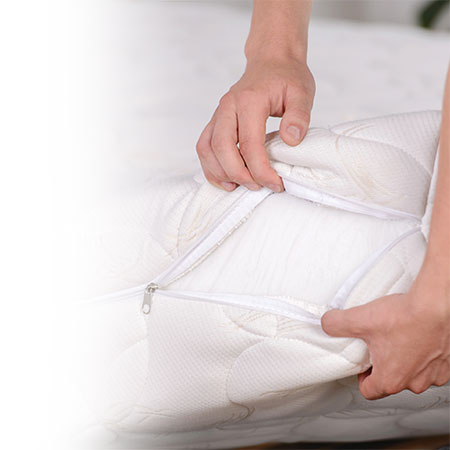Eliminating a bedbug invasion requires several steps and a lot of effort. Choose a preventive approach to avoid receiving these unwanted visitors!
Detecting bedbugs
Bedbugs are the size of an apple seed. When they bite, they turn from a brown colour to a reddish one. They feed off human blood. They move at the speed of an ant and are visible to the naked eye. They do not fly or jump. They have a life span of 5 to 10 months, but can live up to 18 months without feeding when they are in the dormant phase.
These small insects can lay up to 200 eggs during their lifetime. Eggs are more difficult to spot, since they are whitish and the size of a pinhead. They take between 10 and 14 days to hatch.
Bedbugs do not like light and are mostly active at night. They like dark, narrow and hard to reach spaces. Mattresses are their living environment of choice, but they can be found in various places:
- bedroom furniture, headboards, linen, box springs, and mattress covers
- drawers, chests, cupboards, and wicker furniture
- packsacks, handbags, clothing, and suitcases
- chairs, armchairs, cushions, and sofas
- carpets and curtains
- mouldings, window frames, and doors
- in cracks (wood, plaster, and floors)
- behind baseboards, electrical outlets and frames
- etc.
In the case of infestation, here are some things you will notice:
- black or brown stains on the bedding, mattress or box spring (bedbug excrement)
- dead or live bedbugs
- bedbug eggs
- insect bites on the body similar to those of a mosquito (often in clusters), and
- on the areas of the body that are exposed during sleep
Insect bites can take up to 14 days before they appear. They can sometimes cause itching, especially early in the morning. Scratching should be avoided so as not to promote a skin infection. Note that bedbugs do not transmit diseases. If itching is significant, wash your skin with cool water and gentle soap. Your pharmacist can recommend products and the measures to be taken to relieve your symptoms.
Eliminating bedbugs
It is strongly recommended to get prompt assistance from a certified exterminator. If you are a tenant, inform the owner of the building as quickly as possible. Avoid applying insecticides yourself, as these products can be dangerous if they are not used properly.
Before starting, the exterminator will ask you to prepare the premises. This step is crucial for a successful treatment.
- Avoid leaving out and about objects and clothing.
- Empty out furniture and drawers.
- Remove curtains and carpets.
- Pass the vacuum in the infested rooms to reduce the number of bedbugs. Vacuuming does not kill bedbugs, so be sure to throw away the vacuum bag in an airtight plastic bag.
- Inspect your mattress, box spring, and padded furniture.
- Wash all objects made of fabric (sheets, clothing, curtains, etc.)
- Wait until the exterminator has completed his task before purchasing new furniture.
The best way to treat fabrics is to put them in the dryer at a high temperature for at least 30 minutes.
If needed, you can wash your clothes in the washer using hot water (at least 60oC) for the duration of the wash cycle. Your clothes must be completely covered with water. If you are using a front-loading washer, make sure the water level is sufficient. If you have a doubt, treat them in the dryer as well.
Objects with fabric can also be treated with hot vapour. The vapour—with a temperature of at least 100oC—must be applied slowly. Only the bedbugs that are exposed to the vapour will die. Moreover, it is preferable to apply this treatment before passing the vacuum, since the vapour will dislodge the bedbugs that are still alive.
The cold can also kill bedbugs. Objects can be placed in the freezer or outdoors for at least four days. Ensure that the temperature is colder or equal to -18oC during the entire time of the treatment. Several residential freezers are not suitable for this treatment. The cooling of the bedbugs must be quick, otherwise they will adapt and survive.
After having treated your objects, fabrics, and clothing, place them in a plastic bag or cover and seal it with adhesive tape. Wait until the exterminator has completed his task before reintroducing the objects inside the room. Throw away any objects that cannot be treated.
Avoiding a bedbug invasion
Here are some useful preventive tips:
- Avoid accumulating clutter.
- Vacuum often, even under beds and behind headboards.
- Do not bring into your home box springs, wood or padded furniture and mattresses that have been left on the side of the street. Carefully examine furniture and books that were bought at flea markets or second-hand shops.
- Because the same trucks are often used to deliver new and used mattresses, demand that your new mattress be delivered in a sealed plastic cover.
- In a hotel, place your suitcase on the bathroom floor, in the bathtub or on a luggage rack. Do not place your clothes in drawers, on the bed or on the floor.
- Do not bring your pillow when you travel.
- When you return from a trip, closely examine your suitcase before putting it away. A light-coloured suitcase made of plastic is best. Bedbugs are less attracted to plastic and will be more easily detected.
- If you are moving, examine the rooms carefully before bringing in your personal effects.
Prevention is the best solution to avoid all the headaches and stress of a bedbug infestation. If, by some misfortune, they manage to enter your home, a quick and thorough intervention will efficiently show them the way out!

